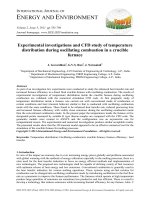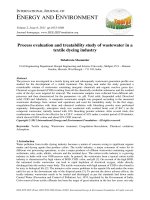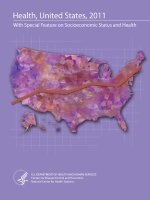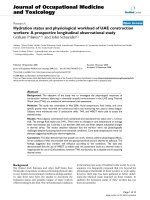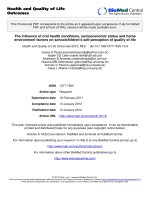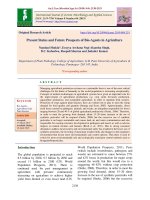Socioeconomic status and livestock study of Bihar, India
Bạn đang xem bản rút gọn của tài liệu. Xem và tải ngay bản đầy đủ của tài liệu tại đây (191.52 KB, 9 trang )
Int.J.Curr.Microbiol.App.Sci (2019) 8(5): 1240-1248
International Journal of Current Microbiology and Applied Sciences
ISSN: 2319-7706 Volume 8 Number 05 (2019)
Journal homepage:
Original Research Article
/>
Socioeconomic Status and Livestock Study of Bihar, India
Vinod V. Potdar*, Jayant R. Khadse, Sachin A. Joshi,
M. Swaminathan, Narayan L. Phadke and Yuvraj S. Gaundare
Genetics Department Central Research Station BAIF Urulikanchan, India
*Corresponding author
ABSTRACT
Keywords
APL, BPL,
Crossbreed,
Upgraded
Article Info
Accepted:
12 April 2019
Available Online:
10 May 2019
To study the knowledge of dairy animal owners in improved dairy husbandry practices a
field survey in Bihar state was conducted during April-June’2016. Data were collected
through personal interview from randomly selected 1550 dairy animal owners from
randomly selected villages from Chhapra, Vaishali district of Bihar with the help of pretested structured schedule. Survey indicates that the 71.67 percentage of the livestock
farmers belonged to middle age category range from 35-50 years, followed by 15.00
percent in young age category and 13.33% belonged to old age category. Female
participants were 40.36 percentage while 45.57 percentage were male participants. The
average size of family in the study was 8.74 persons with 4.75 male members and 4.0
female members. 65.4% of the respondents’ family was formally educated followed 34.6%
of the respondents’ family were not formally educated. In the present study it was
observed that 30.7% of the respondents had acquired education up to 10th and 19.8% of
respondents had acquired education upto 12th class. 13.3% of respondents had acquired
education upto graduate and post graduate level while 13% of respondents had acquired
education upto 5th class. Survey data revealed that the highest respondents were from
OBC 59.4% class followed by 29.8% General Caste. Percentage of schedule caste was
8.1% and percentage of schedule tribe was 2.7 %. Average size of land owned was 2.24
percentage. 71.0 percentage belong to Marginal (0.1-1 ha) land while 13.7 percentage
belong to small (1.1-2 ha), 3.5 percentage belong to owners having above 2 ha land.
Average number of animals owned were 1.99 while average number of cow owned were
1.75. Average number of buffaloes owned was 0.24. For distribution of cows and buffaloes
by type of breed show highest proportion was of crossbreed cow 75.92 percentage
followed by 20.46 percentage of Indigenous cow and 3.62 percentage of Non-descript
cow. In case of buffaloes it shows 55.76 percentage of upgraded buffalo and 44.24
percentage of non-descript buffaloes. In milk market study about 38.7% of farmers sell
their milk to private dairy, followed by cooperative dairy (33.0%) and open market
(28.2%). Likewise the average quantity of milk sold per farmer per day to private dairy
was 2.72 litres, 2.32 litres to cooperative dairy and 1.98 litres to open market. Around
62.9% of the farmers sell their milk within the village while the remaining 37.1% farmers
sell milk outside the village.
1240
Int.J.Curr.Microbiol.App.Sci (2019) 8(5): 1240-1248
Introduction
India is predominantly an agricultural country
with about 70% of its population dependent
on income from agriculture. Animal
husbandry is an adjunct to crop agriculture
and cattle is kept for milk production, motive
power for various farm operations, village
transport, irrigation, and production of
manure. The animals are generally maintained
on agricultural byproducts and crop residues.
Animal rearing is done mostly by small and
marginal farmers and landless labourers.
Livestock rearing provides employment and
supplementary income to the vast majority of
rural households, the majority of whom are
landless and marginal farmers. Thus
knowledge on existing management practices
may help to identify strength and weakness of
the dairy sector which could be further useful
for formulation of proper intervention
policies. With this backdrop, present study
was designed to document existing
information on housing management practices
followed by the dairy farmers in Bihar.
Materials and Methods
BAIF has accomplished all the envisaged
activities during the Pilot phase by the end of
May 2016. After the project completion,
BAIF arranged to conduct an Impact
Assessment Study to document the project
outcome and the lessons learnt which would
be useful for Research & Development as
well as while taking future policy decisions
for replication and up-scaling of similar
programs. This task has been assigned to
CMSR, New Delhi which undertook the
Impact Assessment Study during AprilJune’2016. This will focus on the Project
achievements. The present study was
conducted in the Chhapra, Samastipur and
Vaishali districts of Bihar. Face to face
interviews were conducted with a total of
1550 farmers. The sample farmers were
chosen from a list of farmers provided by
BAIF. This study presents information on the
socio-economic characteristics of farmers
(through face to face interview), their animal
management practices, willingness to be a
part of federation and readiness to incur
expenditure
for
availing
artificial
insemination. An attempt was also made to
compute income from milking animals and
benefits of crossbreeding and upgrading of
cattle to assess the impact of project. The data
collected have been analyzed and tables (1–9)
have been prepared and inferences drawn.
Results and Discussion
The survey was conducted in Bihar from 1550
farmers. The analysis of the conducted study
is as follow
Age
The age of respondents is an important factor,
which determines the maturity of an
individual and has a bearing on thinking,
experience, decision making and exposure of
a person. The data in the (Table 1) indicates
that the highest percentage of the livestock
farmers (71.67%) belonged to middle age
category, i.e. 35-50 years, followed by 15.00
percent in young age category and rest
(13.33%) belonged to old age category. It was
observed that minimum age was 24 years and
highest age was 73 years.
Balakrishna (1997), Mary (2001), Sabapara et
al., (2014) also found that majority of
respondents were in middle age group. It
could be observed from (Table 1) that
maximum number of owners of small scale
livestock farmer lies in age group 35-50
years. About 87% owners of small-scale
livestock farmer lie in age group 18-50 years.
Therefore, it may be said that small scale
livestock farms are mainly run by young to
middle age people. It can be concluded from
1241
Int.J.Curr.Microbiol.App.Sci (2019) 8(5): 1240-1248
the (Table 1) that middle age category prefer
livestock farming for maintaining their
livelihood.
Gender
The results on the gender of the farmers
involved in dairy farming activities are
presented in Table 2. From the table it is
observed that majority of the dairy farmers,
are women (40.36 per cent) followed by men
(45.57 per cent). Similar findings were
recorded in communes and municipalities
with minor numerical variations. This finding
is in agreement with Prakash et al., (2011),
Hai et al., (2011) and Anika et al., (2015)
who found that rural women played an
important and substantial role in dairy
farming.
Average size of household
The average size of family in the sample was
8.74 persons with 4.75 male members and 4.0
female members. All the households had
more male members as compared to female
members. This is also in tune with the
demographic pattern of the country
Family size
The family size of the farmers in the study
area that are shown in (Table 2) indicated that
more than half (55.83%) were of medium
family size ranging from 6 to 8 members,
followed by 23.33 percent in high and 20.84
percent in small family size category. This is
lower than the observation of Rao (1986).
Family size influences various activities in
term of family labour availability, annual
income of family etc. It was also observed
that in majority the livestock are maintained
by all the family members collectively.
Similar findings were revealed by Kumar
(2001), Gupta (2011).
Education status
The data shown in (Table 3) revealed that
65.4% of the respondents’ family was
formally educated followed 34.6% of the
respondents’ family were not formally
educated. In the present study The (Table 3)
reveals that 30.7% of the respondents had
acquired education up to 10th and 19.8% of
respondents had acquired education upto 12th
class. 13.3% of respondents had acquired
education upto graduate and post graduate
level while 13% of respondents had acquired
education upto 5th class. In similar studies
Garai (2007), Sahoo (2011), Verma (2012)
has also reported low education status among
the tribal people. Low level of education
status may be on account of less schools and
distant location of the schools in the locality
and frequent destructions of school building
due to insurgency. Vivek et al., (2015)
revealed that 45.31 per cent of cattle owners
were illiterate and 54.69 per cent were literate
in Western Rajasthan.
Caste
Analysis of the data revealed that the highest
respondent were from OBC (59.4%) class
followed by 29.8% General Caste. Percentage
of schedule caste was 8.1% and percentage of
schedule tribe was 2.7 %. Parashari and Khan
(2015) observed that OBCs have highest
share of 41.33% followed by high castes with
a proportion of 32.66% and SCs have least
proportion of 27.33% in total people involved
in dairy farming. Sabapara et al., (2014)
observed that the majority of the respondents
(40%) were from OBC category followed by
ST (39.33%), General category (13.67%) and
SC (7%) in dairy husbandry practices.
Gangasagare and Karanjkar (2009) reported
that about 59% of the dairy farmers belong to
General category, 25% were OBCs and only
8% each of SC and ST in the milk pocket
1242
Int.J.Curr.Microbiol.App.Sci (2019) 8(5): 1240-1248
areas of eight districts of Marathwada region
of Maharashtra.
et al., (2005) who found that medium herd
size was more in Chennai.
Land holding
Total cattle 2708 and 373 buffaloes were
surveyed for distribution of cows and
buffaloes by type of breed show highest
proportion was of crossbreed cow 75.92
percentage, 20.46 percentage of Indigenous
cow and 3.62 percentage of Non-descript
cow. In case of buffaloes upgraded buffalo
55.76 percentage, 44.24 percentage of nondescript buffaloes.
Majority of the dairy farmers were owing land
(88.2 percent) while 11.8 percent were not
having own land. Overall average size of land
owned was 2.24 percentage. 71.0 percentage
belong to Marginal (0.1-1 ha) land while 13.7
percentage belong to small (1.1-2 ha), 3.5
percentage belong to owners having above 2
ha land. The results were almost similar to the
findings of Vinothini (2010) who found that
majority (60 percent) of the dairy farmers
were landless and average land holding was
0.86 acre in Puducherry. These finding are in
accordance with the finding of Gupta (2011).
Herd size
Average number of animals owned were 1.99
while average number of cow owned were
1.75. Average number of buffaloes owned
was 0.24. The results were almost similar to
the findings of Ramkumar et al., (2001),
Tamizhkumaran and Rao (2012) and Vivek et
al., (2015) who found that dairy farmers had
small herd size of cattle. The results were
contradicting with the results of Senthilkumar
Marketing of milk
As regards to the number of milking animals
number of milking animals owned by farmers
in Bihar was 1375. Average number of
milking animals owned by the sample
household was 1.19 in Bihar.
Selling point for milk
This table pertains to three aspects; place
where the farmers sell their milk, location
(within village/outside village) and distance
travelled by them for selling milk. Total
number of farmers who sell their milk was
949.
Table.1 Distribution of farmers by age group and gender (%)
Age(in years)
Up to 20
21 - 30
31 - 40
41 - 50
51 - 60
> 60
Average age
Total
number
farmers
Gender
Male
2.2
10.8
22.6
26.5
19.9
18.1
45.57
of 2649
Bihar
Female
4.3
14.8
34.8
26.2
14.2
5.7
40.36
351
1243
0.6
7.4
19.3
27.2
21.7
23.9
48.16
1550
Int.J.Curr.Microbiol.App.Sci (2019) 8(5): 1240-1248
Table.2 Distribution of farmers by average number of male and female members per household (%)
Gender
Male
Female
Average family size
Bihar
4.75
4.00
8.74
Table.3 Distribution of male and female farmers by educational status (%)
Farmers by their education level
Farmers who were not formally educated (n)
Male
Female
Farmers who had formal education (n)
-5th Pass
-8th Pass
-10th Pass
-12th Pass
-Graduates/Post Graduates
Total number of farmers
Number
536 (34.6%)
91.2
8.8
1014 (65.4)
13.0
20.4
30.7
19.8
13.3
1550
Table.4 Distribution of farmers by social category (%)
Caste
Scheduled caste
Scheduled tribe
Other backward class
General
Total
number
of
farmers
Number
8.1
2.7
59.4
29.8
1550
Table.5 Distribution of farmers by land holding status (%)
Land ownership
Farmers not owning land (n)
(%)
Farmers owning land (n)
(%)
Size of land owned
Marginal (0.1-1ha)
Small (1.1- 2 ha)
Above 2 Ha
Average size of land owned
Total no. of farmers
Bihar
227
11.8
1323
88.2
71.0
13.7
3.5
2.24
1550
1244
Int.J.Curr.Microbiol.App.Sci (2019) 8(5): 1240-1248
Table.6 Average number of female animals owned by farmers in the sample states
Breed of cattle
Bihar
Total number of female animals owned by farmers
3081
Average number of animals owned
1.99
Average number of cows owned
1.75
Average number of buffaloes owned
0.24
Table.7 Distribution of cows and buffaloes by type of breed
Breed of cattle
Bihar
ND Cow
Crossbred Cow
Indigenous Cow
Total number of Cows
ND Buffalo
Upgraded Buffalo
Total number of Buffaloes
Cattle owned (n)
%
98
2056
554
2708
165
208
373
3.62
75.92
20.46
100.00
44.24
55.76
100.00
Table.8 Distribution of farmers by place of sale, location and distance travelled
Place for sale of milk
Open Market (in litres)
Cooperative Dairy (in litres)
Private Dairy (in litres)
Average quantity of milk sold
Farmers who sell milk (n)
Location of the sale point
Within the village (%)
Outside the village (%)
If outside the village distance
travelled (n)
Less than 3 Km (%)
More than 3 Km (%)
Bihar
% of farmers
28.2
33.0
38.7
949
62.9
37.1
352
91.5
8.5
1245
Ave. quant sold (per farmer
per day).
1.98
2.32
2.72
7.02
Int.J.Curr.Microbiol.App.Sci (2019) 8(5): 1240-1248
Table.9 Comparison of feed and fodder consumption in cattle and buffalo
Particulars
Concentrate is fed per day (in Kg)
Fed no. of days in a year
Dry Fodder is fed per day (in Kg)
Green fodder fed per day (in Kg)
Mineral mixture fed per day (in Kg)
Total expenditure incurred per animal per annum (in Rs.)
Total expenditure incurred on health per animal per annum (in
Rs.)
Cattle
3.86
319
7.43
10.84
0.04
27377
2608
Buffalo
4.51
244
9.83
237
0.04
26181
2851
animals. In Bihar only 0.34 percent farmers
do insurance.
Place of sale
It was stated that maximum proportion
(38.7%) of farmers sell their milk to private
dairy, followed by cooperative dairy (33.0%)
and open market (28.2%). Likewisethe
average quantity of milk sold per farmer per
day to private dairy was 2.72 litres, 2.32 litres
to cooperative dairy and 1.98 litres to open
market.
Artificial
insemination
conception
needed
for
The average number of AIs done for the
crossbred cows was higher (2.04 AIs) than the
AIs done for indigenous cows (1.94 AIs). The
average number of AIs done among the
upgraded buffaloes was 1.71 AIs.
Location
Price of pregnant cattle
Around 62.9% of the farmers sell their milk
within the village while the remaining 37.1%
farmers sell milk outside the village.
Distance travelled
Majority of the farmers (37.1%) who sell their
milk outside the village, had to travel a
distance of less than 3 km and the remaining
15.9% had to cover a distance of more than 3
km to sell their milk. In Bihar, only 8%
farmers had to travel more than 3 km to sell
milk.
Insurance of livestock
It was noticed that although most of the
farmers had heard of animal insurance, it was
not a very popular practice among them as the
data revealed that in the more than 99 percent
of the farmers did not insure any of their
The average price at which a Crossbred cows
pregnant cow was sold was Rs. 24,090. The
overall average price at which a Indigenous
pregnant cow was sold was Rs.14, 986. The
average price at which a pregnant buffalo was
sold was for Rs. 32938.
It can be concluded that majority of the
respondents were middle and above aged and
literate up-to secondary standard of education
with medium family size. Majority of the
respondents possessed land with small and
medium herd size. A large number of dairy
farmers were found belonging to medium
category for their experience in dairying
while, majority of dairy farmers were having
medium family size and Dairy farmers were
having medium land holding (2-4 hectare)
and milk production. From demographic
profile, housing and feeding systems study, it
1246
Int.J.Curr.Microbiol.App.Sci (2019) 8(5): 1240-1248
can be concluded that dairy farming is still an
occupation of poor community. For any dairy
improvement programme, male and female
members should be engaged in training
programme. Training should be offered in
such a way that illiterate people can follow
this. Awareness programme should be
strengthened in light of providing housing to
the dairy which is essential for scientific dairy
production management; dairy rearing away
from human dwelling as they may transmit
zoonotic diseases; and improving the
condition of the dairy houses including floor
and roof.
Acknowledgements
The authors are thankful to Management team
of BAIF Development Research Foundation
and all stakeholders in study area those who
participated and cooperated during study
References
Anika, M., Gautam and Kamaldeep. (2015).
Relative contribution of rural women to
animal husbandry activities in Haryana.
Asian Journal of Animal Sciences.
10(1): 43–48.
Balakrishnan B. 1997. Evaluation of dairy
production practices in selected farming
system of Karnataka state. Ph. D.
Thesis, NDRI (Deemed University),
Karnal, Haryana.
Garai S. 2007. Dairy farming among Santhal
tribe women of Bardhman district West
Bengal. M. Sc. Thesis, National Dairy
Research Institute (Deemed University),
Karnal, Haryana
Gangasagare, P. T. and Karanjkar, L. M.
2009. Status of milk production and
economic profile of dairy farmers in the
Marathwada region of Maharashtra.
Vet. World, 2: 317-320
Gupta P. 2011. Status and prospects of
smallholder milk production system in
Easter Haryana. M. V. Sc. Thesis,
National Dairy Research Institute
(Deemed University), Karnal, Haryana.
Hai, A., Akand, A. H., Shanaz, S. and Bulbul,
K. H. (2011). Contribution of farm
women towards dairy enterprise in
Ganderbal district of Kashmir valley.
Journal of Dairying, Foods & Home
sciences, 30 (2): 140 – 146.
Kumar S. 2001. A study on delivery system
of the animal husbandry inputs in Banka
district (Bihar). M. Sc. Thesis, National
Dairy Research Institute (Deemed
University), Karnal, Haryana.
Prakash, K. R., Nikam, T. R., Sariput, L.,
Vajreshwari and Amit, H. (2011).
Participation of rural women in dairy
farming in Karnataka. Indian Research
Journal of Extension Education. 11 (2):
56- 61
Ramkumar, S., Chris Garforth., Rao, S. V. N.,
Kevin Waldie. (2001). Landless
livestock farming – problems and
prospects, In Proceedings of workshop
held at RAGACOVAS, Puducherry. 31
-35.
Sabapara G P, Fulsoundar A B S and Kharadi
V B. 2014. Personal, socio-economic
characteristics of dairy animal owners
and their relationship with knowledge
of dairy husbandry practices in Surat
district of Gujarat. Journal of Animal
Research 4(2): 175-186.
Sahoo A, Meena H R, Ram H and Rasool T J.
2011. Livestock animal husbandry
scenario at high altitude Kumanen
Himalaya. Indian Journal of Animal
Sciences 78(8): 882-886.
Senthilkumar, T., Sudeepkumar, N. K. and
Subramanian. (2005). Profile of urban
dairy farmers utilising mobile artificial
insemination services in Tamil Nadu.
Journal of Extension Education.
16(1&2): 3745-3748.
Tamizhkumaran, J. and Rao, S. V. N.
(2012).Why cultivation of azolla as
1247
Int.J.Curr.Microbiol.App.Sci (2019) 8(5): 1240-1248
cattle feed not sustainable? Indian
Journal of Dairy Sciences. 65(4): 348353.
Verma H C. 2012. Productive and
reproductive performances of dairy
animals in Faizabad district of Uttar
Pradesh. M. V. Sc. Thesis, National
Dairy Research Institute (Deemed
University), Karnal, Haryana.
Vivek, M., Vijay, Jay, S, S., Mohan, L, Y.,
Sanjay, K and Saroj, C. (2015). Study
about socio-economic status and calf
rearing management practices adopted
by cattle keepers of Western Rajasthan.
Indian Journal of Agriculture Research.
49(2): 189-192.
Vinothini, M. (2010). A study on
sustainability of dairy farming among
the members of women dairy
cooperative societies in Puducherry.
M.V.Sc thesis, RIVER, Puducherry.
How to cite this article:
Vinod V. Potdar, Jayant R. Khadse, Sachin A. Joshi, M. Swaminathan, Narayan L. Phadke and
Yuvraj S. Gaundare. 2019. Socioeconomic Status and Livestock Study of Bihar, India.
Int.J.Curr.Microbiol.App.Sci. 8(05): 1240-1248. doi: />
1248
